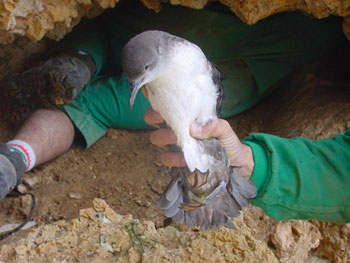Meritxell Genovart (Population Ecology Group, Institut Mediterrani d'Estudis Avançats IMEDEA (CSIC-UIB), Mallorca, Spain) and colleagues, writing in the Journal of Heredity have compared the genetic and phenotypic characters of the Balearic Shearwater Puffinus mauretanicus, now an ACAP-listed species, with the closely-related Yelkouan Shearwater P. yelkouan.
The paper's abstract follows:
"Understanding the demographic and evolutionary processes within and between populations is essential for developing effective management strategies. Thus, for establishing good conservation policies both genetic and phenotypic studies are crucial. We carried out an integrated analysis of genetic and phenotypic characters of the critically endangered Balearic shearwater Puffinus mauretanicus (182 individuals) and compared them with those of 2 nearby colonies of Yelkouan shearwater P. yelkouan (40 individuals), a species for which hybridization has been hypothesized. The results of the microsatellite analyses were compared with previous mitochondrial DNA analyses. Genetic variability was low in the Balearic shearwater and high levels of inbreeding were revealed at local scale. Most dispersal in Balearic shearwaters was to neighboring sites, even though low levels of population structure were found. The admixture between the 2 species was much higher at nuclear than at mitochondrial level, but phenotypic characters would seem to indicate that a lower level of admixture exists. Individual nuclear DNA, mtDNA, and phenotype did not match at individual level, showing that migration alone cannot explain this phenomenon. We suggest that these 2 young shearwater species could have been involved in processes of divergence and admixing. However, due to the longer coalescence times in nuclear markers, incomplete lineage sorting cannot be ruled out."

Balearic Shearwater in the hand. Photograph by Daniel Oro
Reference:
Meritxell Genovart, M., Juste, J., Contreras-Diaz, H. & Oro, D. 2012. Phenotypic differentiation between the Critically Endangered Balearic Shearwater and neighboring colonies of its sibling species. Journal of Heredity 103: 330-341.
John Cooper, ACAP Information Officer, 19 May 2012

 English
English  Français
Français  Español
Español